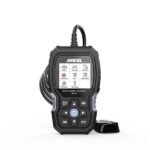Experiencing issues with your 2014 Honda Civic passing an emissions test due to unset readiness monitors? You’re not alone. Many vehicle owners face this hurdle. The On-Board Diagnostics II (OBD2) system in your Honda Civic needs to complete a self-test, known as a drive cycle, to ensure all emission control systems are functioning correctly. This article will guide you through the OBD2 drive cycle specifically for your 2014 Honda Civic, helping you get those monitors ready for inspection.
Understanding the OBD2 Drive Cycle for Your 2014 Honda Civic
The OBD2 drive cycle is a series of specific driving conditions that your 2014 Honda Civic needs to experience to run comprehensive diagnostics. It’s designed to evaluate various emission control systems, such as the oxygen sensors, catalytic converter, EVAP system, and EGR system. If these monitors are not “ready,” it often means the full diagnostic tests haven’t been completed, which can result in failing an emissions test.
Starting Conditions for the OBD2 Drive Cycle
Before initiating the drive cycle on your 2014 Honda Civic, ensure the following conditions are met for a proper cold start:
- Cold Start: The engine coolant temperature must be below 122 degrees Fahrenheit (50 degrees Celsius). Ideally, the ambient air temperature and coolant temperature should be within 11 degrees Fahrenheit (6 degrees Celsius) of each other. This typically means starting the drive cycle after the vehicle has been sitting overnight.
- Ignition Key Position: Do not turn the ignition key to the “ON” position before starting the engine. Doing so may prevent the heated oxygen sensor diagnostic from running correctly.
Step-by-Step OBD2 Drive Cycle Procedure for 2014 Honda Civic
Follow these steps carefully to perform the OBD2 drive cycle on your 2014 Honda Civic:
-
Initial Idle: Start the engine and let it idle in drive for two and a half minutes. Turn on the air conditioning (A/C) and the rear defroster during this step. This allows the OBD2 system to check the oxygen sensor heater circuits, air pump (if equipped), and EVAP purge system.
-
Moderate Acceleration and Steady Speed: Turn off the A/C and rear defroster. Accelerate smoothly to 55 mph (88 km/h) at approximately half throttle. This phase allows the OBD2 system to check for ignition misfires, fuel trim accuracy, and canister purge function. Maintain a steady speed of 55 mph for three minutes. During this constant speed, the system monitors the EGR system, air pump, oxygen sensors, and canister purge system.
-
Deceleration: Safely decelerate (coast down) to 20 mph (32 km/h) without applying the brakes or depressing the clutch (for manual transmissions). This step allows the OBD2 system to evaluate the EGR and purge functions during deceleration.
-
Re-acceleration and Steady Speed: Accelerate again to 55 to 60 mph (88-96 km/h) at half throttle. This re-checks for misfires, fuel trim, and purge system operation under acceleration conditions.
-
Extended Steady Speed: Maintain a steady speed between 55 and 60 mph for five minutes. This extended period allows the OBD2 system to thoroughly monitor the catalytic converter efficiency, misfires, EGR system, fuel trim, oxygen sensors, and purge functions.
-
Final Deceleration and Idle: Decelerate (coast down) to a complete stop without using the brakes. Once stopped, the OBD2 system performs a final check of the EGR and canister purge systems.
Important Considerations and Potential Issues
- Traffic Conditions: Perform this drive cycle in a safe area where you can maintain steady speeds and decelerate without causing a hazard. Early morning or late evening on less congested roads might be ideal.
- Repeating the Drive Cycle: It may be necessary to repeat the OBD2 drive cycle multiple times for all readiness monitors to set, especially if you’ve recently cleared trouble codes or disconnected the battery.
- Underlying Issues: If your readiness monitors are consistently not setting even after multiple drive cycles, there might be an underlying mechanical or electrical issue with your 2014 Honda Civic that needs professional diagnosis and repair. A scan tool can help identify specific trouble codes that are preventing monitor readiness.
- Scan Tool Verification: Use an OBD2 scan tool to check the readiness monitor status after performing the drive cycle. This will confirm whether the monitors have successfully set and if your 2014 Honda Civic is ready for an emissions test.
By following these steps, you can effectively perform an OBD2 drive cycle on your 2014 Honda Civic and increase the chances of passing your emissions test. Remember to prioritize safety and consider professional assistance if issues persist.
